Technical notes
Java JDK
CAST supports the analysis of Java JDK with some limitations. These limitations are listed below, but are not exhaustive:
- Compilation errors are not always noticed by the JEE Analyzer.
- Compilation errors due to generics are not detected. To avoid analysis interpretation issues you must ensure that the source code that references generics does actually compile.
- The Java interface related to the implementation of an annotation is not stored in the CAST Analysis Service database. Note that this doesn’t mean that annotation properties of classes, interfaces and … are not stored in the CAST Analysis Service database.
- Java source code may contain Unicode escapes in Literals or Identifiers but not in Keywords, Operators or Separators. The JEE Analyzer would produce a syntax warning for unsupported cases.
JPA / Hibernate
JPA 2.0 / Hibernate 4
Basic or Embeddable types
Collections of Basic or Embeddable types are supported so that links between these entities and the data table is identified.
@org.hibernate.annotations.Entity
In Hibernate 4, @org.hibernate.annotations.Entity has been deprecated and the advice is to replace its individual attributes/values with annotations. For example, the following:
@Entity(dynamicUpdate = true)
Class MyEntity {
}
should be replaced with:
@Entity
@SelectBeforeUpdate
Class MyEntity {
}
CAST supports this change and in particular the following Quality Rules will still function correctly:
-
Avoid select-before-update when the Table is not associated to an UPDATE Trigger (7634)
-
Avoid UPDATE trigger firing when not necessary (7490)
JPA 2.1 / Hibernate 4.3 - 5.x
Access to database stored procedures using one of the below mechanisms is now supported:
- Via the annotation @NamedStoredProcedureQuery
- Or via the tag named-stored-procedure-query when configuring via XML in orm.xml
JEE Web Apps
Support of Java Servlet annotations
The Java Servlet annotation @WebServlet introduced in JEE 1.6 (Java Servlet 3.0) is now supported by CAST AIP and links between JSP and Java files made using this annotation will be correctly resolved by CAST AIP. Important notes:
- CAST AIP will:
- create prototype links from the servlet to the annotated class
- create a servlet mapping for each urlPatterns whose parent is the servlet and create an access page forward link to the servlet
- handle any URL matching the urlPatterns to create the correctlink (on Struts - the action mapping, JSF - the managed bean), when not defined on the servlet mapping
- Other annotations provided in the javax.servlet.annotations package are not supported, however, their presence in Application source code will not cause warnings in the analysis log.
Note that by default, the analyzer will assume that the source code always uses the latest JEE Servlet release, however, this can be overridden and a specific release can be selected:
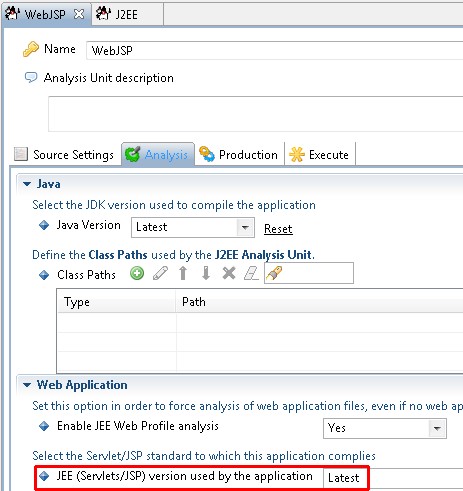
Spring Framework
Spring 1.2.8
While using the Spring Framework 1.2.8 environment profile, the J2EE analyzer does not create objects for bean properties. As a consequence, links are created directly between beans, no matter if the reference to another bean occurs inside a property or inside an anonymous bean.
Spring 3.x
@bean and @configuration annotations are supported. For example with the following source code:
package com.sample;
@Configuration @Lazy("false")
public class AppConfig {
@Bean(autowire=NO) @Scope("prototype")
public MyService myService()
{ toto(); return new MyServiceImpl(); }
}
A Spring bean myService will be created with a RelyOn link to the MyServiceImpl class with the following properties:
- singleton: false
- lazy-init: true
- autowire: false
- ImplementationClass: initialized com.sample.MyServiceImpl
In addition, a RelyOn link will be created to the class com.sample.MyServiceImpl.
Spring 4.x
Includes support for @Query annotation.
Spring Batch
Spring Batch is supported as standard by the JEE Analyzer: by default, Spring frameworks present in the delivered source code will be analyzed and objects / links relating to Spring Batch will be detected and stored in the results:
Objects detected:
- Spring Batch Job
- Spring Batch Step (belonging to Spring Batch Jobs)
Links resolved:
- Call links from the Spring Batch Steps to the Spring beans implementing the operation (read/process/write)
- accessExecLink links between the java method (or initializer) that calls “run”, to the Spring Batch Job
A Spring Batch extension also exists which provides dedicated support for the Spring Batch framework. CAST highly recommends that you install and use this extension if your application contains Spring Batch source code:
- No further development of Spring Batch support will be added in any future release of the JEE Analyzer - all future development will be done in the Spring Batch extension
- Any Spring Batch related objects created by the JEE Analyzer will be deleted and replaced with corresponding objects created by the Spring Batch extension. You should therefore expect a small impact on existing analysis results in terms of the number of added/deleted objects.
Struts Framework
2.x
Support includes the following annotations:
- @Action, @Actions
- @Result
- @Namespace, @Namespaces
- @ParentPackage
1.0/1.1
Configuration types
The following Struts configuration types are not supported:
- By naming convention
- By annotation
This means that the analyzer must have the struts.xml file to deduce the relations between Struts actions and Java.
OGNL
OGNL: the language that permits to query objects properties from the JSP or from the XML is not supported and have the following consequences:
- We have no links from JSP pages to the Action getter/setter methods used to fill the JSP page
- We have no links from a Struts Action to another Struts Action when the action is specified with OGNL in the struts.xml fi
Scope Attributes
No scope attributes for Struts 2.x are created since Struts 2.x use the value stack to get these values.
JSP
- JSP Documents are not supported. This may lead to syntax errors during server-side and/or client-side code analysis.
- Tag Files can be packaged in the /META-INF/tags/ directory in a JAR file installed in the /WEB-INF/lib/ directory of the web application. In this context, you should extract the Tag Files to an equivalent /META-INF/tags/ folder under your application root path (at the same level as the WEB-INF folder) before the JEE Analyzer can process them.
Support for classic JSP via the HTML5/JavaScript extension
CAST recommends using the HTML5 and JavaScript extension to analyze classic JSP applications (JSP versions 1.1 - 2.3) - this is because the JEE Analyzer is not capable of analyzing the JavaScript elements of the JSP application. Below is a screenshot of the analysis of a classic JSP application using the HTML5/JavaScript extension - click to enlarge:
EL Expressions
EL expressions for JSP 2.0 that appear in tag attribute values and template data (client-side code) are supported.
Note that EL 2.1 is not supported.
Enabling/ Disabling EL expressions
With regard to the JSP 2.0 specifications, EL expressions can be disabled in three ways (these three methods of disabling EL expressions are all supported by CAST):
-
Using the page or tag directive as follows (note that the J2EE analyzer applies this setting sequentially: true is used for the remaining of the translation unit (main .jsp page plus included files) until it finds the same directive with another value for the isELIgnored attribute).
<%@ page isELIgnored=“true” %> <%@ tag isELIgnored=" true" %>
-
Escaping any string starting with “${” as show below:
${customer.name}
-
Using a jsp-config element within web.xml:
/jsp/cal/cal1.jsp true
What does the JEE Analyzer do with an EL expression?
An EL expression has the form ${ expression }, where expression corresponds to the expression to interpret. The expression may have one of the following forms:
${ term1 operator term2 }
${ unaire-oprator term }
${ term1 operator term2 operator term3 [operator term*]... }
Each term can be:
- Primary Type
Since everything is an object in EL, the result of the evaluation of a primary type is its corresponding “wrapper class” (i.e. java.lang.Integer for int).
- Implicit Objects
The following objects are implicitly created and stored in the Knowledge Base (even thought they do not actually host a child object).
- sessionScope (hosts all session scope attributes/beans)
- requestScope (hosts all request scope attributes/beans)
- applicationScope (hosts all application scope attributes/beans)
They have the JSP Attributes Scope type. Other EL implicit objects deal with HTTP headers/request parameters and cookies. Since no object is created elsewhere for these elements (not supported yet), they are also not taken into account while analyzing EL expressions (resolution would never succeed).
With the example:
- ${ sessionScope[“book”].title}
…the analyzer will look for a bean named book within the session scope (as child of the sessionScope Object) and only within that scope. If the lookup is successful then:
- A Bean Property object named title is created as a child of the book bean.
- Let T be the java Type of the book bean and F a method we will look for within T.
If T is a List (implements java.util.List) or a Map (implements java.util.Map) then F is get (java.lang.Object). Otherwise F is getTitle() (Title is the property name). If F could be resolved within T, let TF be the return type of F. The following links are created:
| Caller | Called | Link Type |
| Page | book | use |
| Tile | TF | Prototype |
| Page |
|
Call |
This process is applied recursively for each part of a qualified bean property name. Note that for expressions within braces ([expression]) that use operators, only the “+” is interpreted if its operands are literals. Hence, ${sessionScope[“book” + 1].title} will work fine if there is a “book1” bean within the session scope.
In other cases, evaluation results to an empty string. This is because there is not yet a reliable way to get actual attributes values.
- Scope attributes
If a term within an expression does not correspond to an implicit object or a primitive type then it is resolved as a scoped attribute (a bean within a scope) in the following scopes: page, session, request then application.
If the term is a qualified bean property name then it is handled as described in the previous paragraph (2) Implicit Objects).
Example:
<tr>
<td>${book.title}</td>
<td>${my:caps(book['title'])}</td>
</tr>
In this example, book is resolved as a scoped attribute (bean). If resolution succeeds, then a bean property is created.
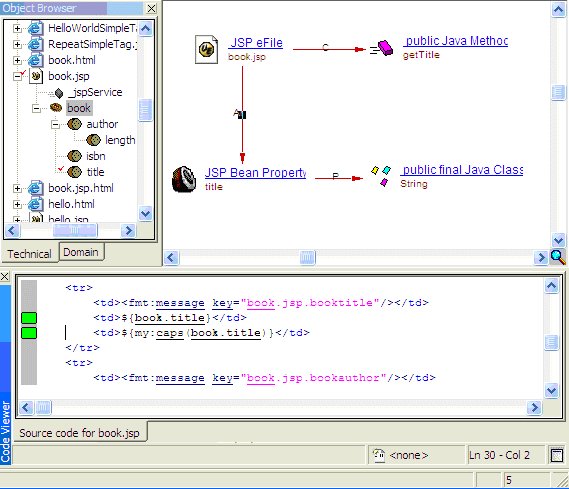
EL Functions
EL functions are Tag Library Descriptor elements. Hence, they are created by the CAST J2EE Analyzer when parsing the containing .tld file. These objects are stored in the Analysis Service and have the JSP EL Function type. An EL Function is used as follows:
${ prefix:FunctionName ( [parameters...] ) }
When a reference to an EL Function is made in an expression, the analyzer resolves the function using the same mechanism it uses for custom tags:
- The prefix is used to find the tld
- The function is then searched for within the found tld.
The table and image below summarize the links/objects that are created:
| Caller | Called | Link Type | When |
| JSP Page | Function | Use | While analyzing EL expression |
| Function | Java Method | Prototype | While analyzing .tld |

Using EL Function in a JSP page:
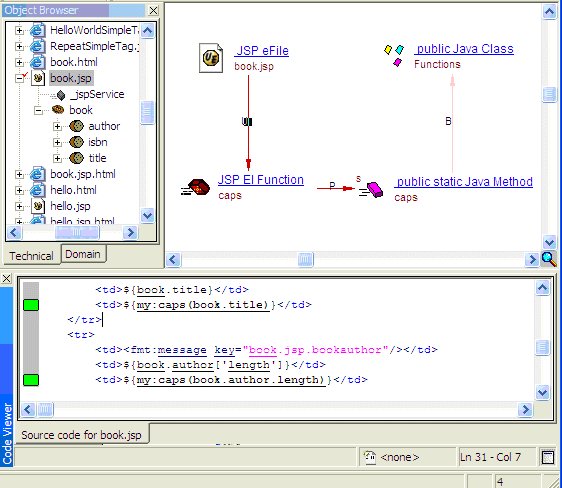
JSE Generics
The JEE Analyzer supports JSE Generics in Java . This section provides detailed information about the various objects that are created during an analysis and how the information is displayed in CAST Enlighten (both in the Object Manager and in the Graphical View):
Objects
The following “Generics” specific objects are created by the analyzer:
| Icon | Object type | Object example |
|---|---|---|
|
Generic Java Class | java.util.HashSet<E> |
|
Generic Java Constructor | static <T> void fromArrayToCollection(T[] a, Collection<T> c) |
|
Generic Java Interface | java.util.Set<T> |
|
Generic Java Method | static <T> void fromArrayToCollection(T[] a, Collection<T> c) |
|
Generic Java Type Parameter | java.util.Set<T> |
|
Java Instantiated Class | java.util.Set<String> |
|
Java Instantiated Constructor | fromArrayToCollection<String>(String[] a, Collection<String> c) |
|
Java Instantiated Interface | java.util.Set<String> |
|
Java Instantiated Method | fromArrayToCollection<String>(String[] a, Collection<String> c) |
Display in CAST Enlighten Object Manager
Java Generics are displayed in the CAST Enlighten Object Manager as shown in the image below:
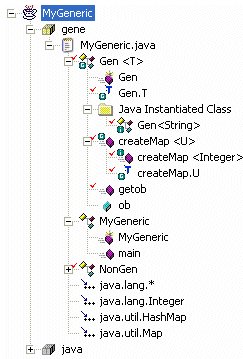
The following information also applies:
- The Generic Java classes and interfaces appear under the Java file that defines them
- The Generic Java methods, constructors and type parameters appear under the class or interface that defines them like a normal class
- The Java instantiated classes and interfaces appear in a subfolder called Instantiation. So, even if the declaration of an instantiated generic class or interface is in a specific file, this class will not appear in the folder related to this file. This is because: it is possible to have the same instantiation in various different files (not just one), and secondly, all the code is in the Generic class and not the instantiated generic class. In addition, it is possible to see whether a Generic class is used or not.
- The Java instantiated constructors and methods also appear as a child of the folder named with the generic constructor or method.
- The generic Java type parameter appears under the Generic class, interface, constructor or method that defines it. Note that its name has been prefixed with the name of the component that defines it to avoid a situation where many Java type parameters appear with the same name T, U etc.
Note that the methods and fields of instantiated classes and interfaces are not represented since their actual implementation is located in the generic class or interface.
Display in the CAST Enlighten Graphical View
Java Generics are displayed in the CAST Enlighten Graphical View as follows:
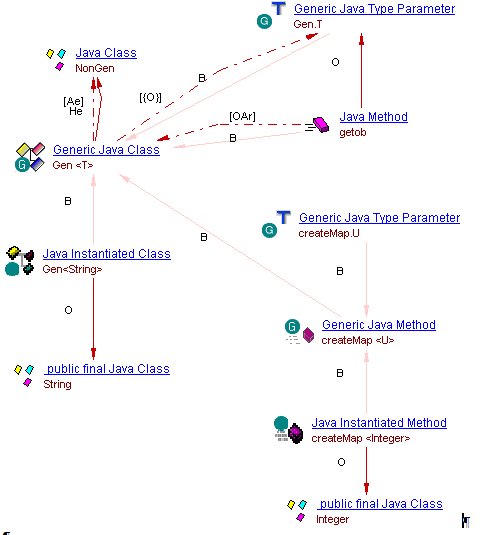
Impacts on Quality Rules
Generic classes, methods and constructors are counted as a standard Java classes, methods and constructors because all the code is inside these objects. Quality Rules will apply to these Generic object types exactly as with any other Java objects. Instantiated classes, methods and constructors are not counted as classes, methods and constructors because they do not handle any code (there is no effort to maintain them), this is why they appear in a specific category.
CDI support
The JEE Analyzer supports CDI (Contexts and Dependency Injection) out of the box. No configuration is necessary.
- Support will follow the Java Version that is set for the source code
- The following annotations/scopes are supported:
- @Inject
- @Named
- @Produces
- @Qualifier
- All scopes, including the following standard scopes
- @SessionScoped
- @RequestScoped
- @Dependent
- Custom scopes built from:
- @Scope
- @NormalScope
- @Named CDI beans used in place of JSF specific injection features (@ManagedBean annotated classes) are supported
- CDI Beans are resolved and saved in the CAST Analysis Service schema whenever a bean qualifier or scope is used to annotate a class.
- Links:
-
A Rely On link will be created from the annotated class (with a scope and/or a qualifier) to the bean.
-
When there is an injection of a class on a field using the @Inject annotation, a Fire link is created from the object the field is injected into, to the constructor(s) of the injected type(s). Though CDI only allows one type to match the injection constraints, many links can be drawn in case of ambiguity, for instance if projects embed more objects than the development environment.
-
Web Services
If your JEE application contains Web Services defined in .WSDL or .WSDD files, the CAST Delivery Manager Tool will identify and package these files correctly according to their extension:
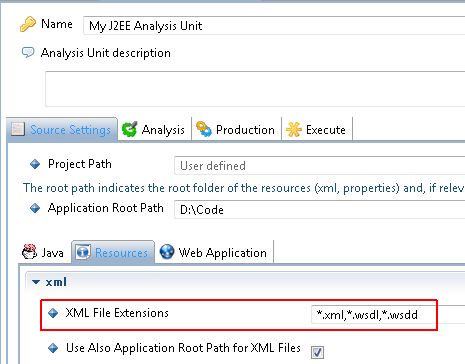
Creation of objects / links
The extension will store (in the CAST Analysis Service schema) objects that represent the description of Web Services using only the contents of WSDL files
These objects include:
- A “WSDL File” object that represents the selected WSDL file and that corresponds to the root node of the file tree of other Web Services objects stored in the CAST Analysis Service schema.
- One or more Web Services objects
- One of more Port objects - children of the Web Service objects
- One or more Port Type objects - children of the WSDL file
- One or more Operation objects - children of the Port Type objects
There is no correlation between the language used to implement the Web Services and the objects stored in the CAST Analysis Service schema.
Belongs To links and those that follow (Internal links) are created during this initial phase:
- Port == Hi ==> Port Type (i)
- Port == U ==> Operation (ii)
The extension will resolve and create implementation links (External links) for the Web Services components stored in the Analysis Service
The link type created is the same for all implementations and should be as follows:
- Port Type == P ==> Object1 (iii)
- Operation == P ==> Object2 (iv)
How are these objects and links constructed?
Objects (Phase 1): Objects result from the analysis of the WSDL files. During this analysis, only the “local names” are taken into account and the files must conform to WSDL 1.1 specifications. The internal link Inherit-Implement (i) is created via a Binding object (represented in the Graphical View but not stored in the Analysis Service schema) that associates the port with a Port Type as follows:
Port > Binding > Port Type
The association Port > Binding is specified in the value of the binding attribute in the tag <port> that declares the Port. This value is a reference in the form prefix:name - the part in bold (prefix) is optional and variable. Only the name is taken into account for the resolution of the corresponding Binding.
The second association is also specified in a similar way, but instead via the value of the type attribute in the <binding> element that declares the Binding. The format is identical and only the name is taken into account in the resolution of the Port Type.
The internal link Use (ii) results from the Belongs To link between the Operations and the Port Type. However, for each Operation under the Port Type that was found in the first phase, a Prototype link will be created from the Port.
External Links (Phase 2): The external links go from the web service objects to the objects of the implementation language (VB, Java etc.)
These links are created on the basis of the correspondence files. These files are, generally, XML files but their format differs from one language to another. As a result, the extension needs to already know the format of these files in their different versions for all the supported languages and thus support of new languages would normally require the revision of the Web Services Asst. code. In order to work around this constraint, a format that is unique to the extension has been developed: an XSLT file is used to transform these files from their proprietary format into the format used by the extension. In order to do this, the extension requires the mapping files to actually transform and the XSLT files to do the transforming. Together these elements are known as Mapping File Profiles to which two labels can be associated (language name and a succinct description of the format of the mapping files) - these two labels are used for identification and selection of the Profile.
How is the support provided?
Support for Web Services is provided through the Environment Profile feature. Assign a Web Services Environment Profile via the Web Service Version drop down list in the JEE - Analysis configuration (Analysis tab), under Frameworks:
What about Mapping Files
In the case of VB the mapping files coincide with the WSDL files. However, their format does not specify a PortType > Language object mapping. The only mappings actually specified are:
- Operation > VB Function
These elements can be found in the value of the soapAction attribute in the tag binding/operation/XXX:operation where XXX: is a variable and optional prefix (soap, wsdlSoap etc.).
- For VB, this value is a URL whose last component is a VB function. During the transformation process, only this part is taken into account.
- For Java under Tibco (Axis in reality), the mapping information
is stored in the WSDD files (Web Services Deployment Descriptor).
These files can store all the information from a group of web
services implementation modules or they can unique to each module.
In the first case, the transformation is applied to one individual
file and all required information must be present. One file with an
absolute path is therefore to be specified as the file to be
transformed (this can be done via a WSDL Environment Profile).
This results in the following:
- Port Type > Class Java
- Operation > Method Java
In order to function correctly, the Web Services Asst. requires the following information:
- Name of the WSDL file containing the components to be mapped.
- For each correspondence:
- WSDL component name (Port Type, Operation)
- Name (qualified name for classes) of the object that implements the component (Java class/method, VB function, TIBCO process etc.).
- Object type (KeysClass value within the Keys table in the knowledge base). A list of VB and Java object types and their object type number is shown below:
| Applet | 5140 |
| Entity Java Bean | 5150 |
| Generic Java Class | 5040 |
| Generic Java Constructor | 5050 |
| Generic Java Interface | 5030 |
| Generic Java Method | 5070 |
| Generic Java Type Parameter | 5045 |
| JDO | 5179 |
| Java Class | 5040 |
| Java Constructor | 5050 |
| Java Data Object | 5180 |
| Java Enum | 5040 |
| Java Enum Item | 5060 |
| Java Field | 5060 |
| Java File | 5170 |
| Java Import | 5171 |
| Java Initializer | 5080 |
| Java Instantiated Class | 5042 |
| Java Instantiated Constructor | 5055 |
| Java Instantiated Interface | 5035 |
| Java Instantiated Method | 5075 |
| Java Interface | 5030 |
| Java Method | 5070 |
| Java Package | 5020 |
| Java Project | 5010 |
| JavaBeans | 5149 |
| Message Driven Java Bean | 5165 |
| Servlet | 11112 |
| Session Java Bean | 5160 |
This information is thus extracted from the mapping files during the transformation process. For Java, this name must be present in the WSDD - if no name exists, the resolution process will stop on the first web component of the type being searched with the name being searched. Please note that the Port Type names appear under the element <service> with the attribute name.
The search for external objects (those specific to each language) follows the Dependency Rules defined in the Dependencies tab in the CAST Management Studio - only those objects associated with the project currently being analyzed must be selected.
Please note that the analyses that create the external objects must have already been executed.
EJB
CAST can support Enterprise Java Beans (EJB) deployment files to EJB 2.0, 2.1 and 3.x specifications. Support is achieved by creating the EJB object and map it with the Java classes constituting the bean (bean class, local and remote interfaces and, for entity beans, primary key class) based on their fully qualified name. Beans are registered in the Analysis Service with their logical name independently of their constituting classes.
How is support provided?
Support for EJB is provided through predefined Environment Profiles:
- By default, the analyzer will assume that EJB 3.x is used in the application source code and will automatically apply this environment profile.
- If your application source code contains EJB 2.x, then you must specifically choose the correct predefined environment profile via the EJB2 Version drop down list in the J2EE Technology options (Analysis tab), under Frameworks. Doing so will deactivate support for EJB 3.x:
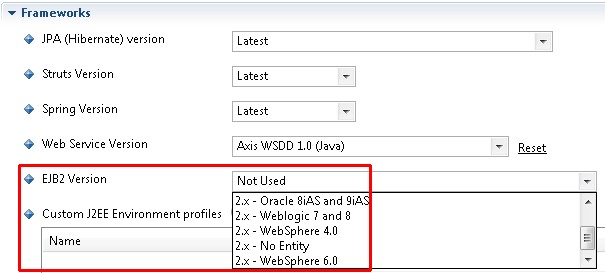
EJB 2.x
The JEE Analyzer supports EJB 2.x specifications and the Web Services support they provide via a varierty of Environment Profiles.
Each EJB 2.x environment profile:
- is nearly identical, with only very slight differences due to configuration for each specific Web Application Server.
- supports EJB 2.x session beans defined in ejb-jar.xml files and in EJB .jar files.
- supports database mapping mechanisms for the selected Web Application Server - if you are not interested in database mapping you can use the “2.x - No Entity” profile since it will only create EJB 2.x session beans and corresponding links.
EJB 3.x
Includes support for JSR 330 @Inject and @Named annotations.
Discovery
Maven
In the maven dependency, the version should be defined or inherited from the parent. Check the packaging of the source code
When packaging a J2EE Maven resource package, if a pom file has a parent, the parent file is not scanned and we may have the following warning message in the discoverer log file:
In the maven dependency, the version should be defined or inherited from the parent. Check the packaging of the source code.
This is a limitation, the parent pom files are not scanned.
Note that this limitation has been removed in CAST AIP ≥ 8.3.8.
Additional notes
The following section lists technical and functional aspects with regard to analysis of JEE source code:
Funnel programming and Strongly Connected Components
Where “funnel programming” causes Strong Connected Components (SCC - see Transaction Configuration Center - Information - Definition and impacts of the large Strongly Connected Component ) a number of ambiguous links may be generated during an analysis. This can in turn cause erroneous Function Point values for Transactions.
Example of “funnel programming”:
- An abstract class called “ABS” exists.
- All of its methods are abstract, except “processFlow”, which is implemented.
- “ABS.processFlow” calls methods “ABS.method1”, “ABS.method2” and “ABS.method3” (which are abstract)
- Classes “B”, “C” and “D” inherit class “A”
- All their methods are overriden but “processFlow” (“processFlow” is already implemented in “A”)
- A method “methodFromZ” from class “Z” does the following:
public methodFromZ(){
B myB = new B();
myB.processFlow();
}
- The analyzer will draw a link from “methodFromZ” to “ABS.processFlow”, and then “ABS.processFlow” will have a link to “B.method1”, “C.method1”, “D.Method1”, “B.Method2”, “C.Method2”, “D.method1”, “D.Method2” which will resemble a “funnel” when viewed in CAST Enlighten.
- CAST recommends creating an “Update CAST Knowledge Base” tool job (Content Enrichment editor in the CAST Management Studio) to remediate situations where Strongly Connected Components exist.
Anonymous classes
Objects are not saved in the CAST Analysis Service schema for anonymous classes and their sub-objects. For example, for the following code where an anonymous class implementing interface “MyInterface” is dynamically created. There will be no object saved in the CAST Analysis Service for this anonymous class, nor for the overriding method “doSomething”:
post( new MyInterface(){
@Override
public void doSomething(){
....
}
);
Java Identifiers containing the ‘$’ character
Identifiers containing the ‘$’ character: ‘$’ is used by java compilers as a class name delimiter in inner class file generation. It is also a legal java character authorized in class names. When reversing class files containing a reference to a class name with a ‘$’, the analyzer can not determine if the ‘$’ should be kept as is or interpreted as a ‘.’ delimiter. It always takes the ‘.’ alternative, meaning that “C$D” will always be interpreted as inner class “D” of class “C”. The impact on the analyzer is that the ‘$’ character is not supported in class names reversed from class files. However it is supported for code defined in java source files.
Overloaded Java methods
J2EE Analyzer cannot distinguish two overloaded methods if the signature (i.e. the name + parameters) of one of them exceeds 1024 characters. Both methods will be considered as one single method and links will be created for only one of them.
JSP unsupported syntax
Comments within the body of an action
JSP comments are not supported within the body of an action (custom and standard).
Use of conditional <c:if> in a <div> element
The use of a conditional <c:if> in a <div> element is not supported and will cause a syntax error when analyzed. For example:
<div <c:if test="${not empty currentNode.properties.classNames}">
class="${currentNode.properties.classNames.string}"
</c:if>
<c:if test="${not empty currentNode.properties.classId}">
id="${currentNode.properties.classId.string}"
</c:if> >
<template:area path="content_${currentNode.name}"/>
</div>
Incorrect JSE registry key in the environment profile
When the registry key specified in a J2EE Environment Profile does not correspond to the real registry key used by the JSE installed on the analysis PC, you should duplicate the Environment Profile of the JSE version that you want to use and reference there the rt.jar of the JSE installed on your machine. Note that duplication is required to ensure that the parameterization related to JSE will be effective for this profile.
Java code in a JSP tag
When analyzing JSP expressions that are the value of attributes in a tag, the analyzer may try to identify a bean with the same name as the java code. The analyzer will not find this bean in the scope as it does not exist. Take the following JSP example:
<logic:equal name="<%=Colors.KEY_COLOR%>" value="<%=Colors.RED%>">
When this code is analyzed by the J2EE Analyzer, the log will contain the following warning:
Bean 'KEY_COLOR%>' not found in scope
Tag Libraries
J2EE Analyzer is unable to take into account attributes that are IMPLIED. This occurs when the TLD references a DTD that contains IMPLIED attributes. When the analyzer encounters such attributes in a JSP page, it gives the following error message in the log: “Attribute ‘xxx’ is not valid for custom tag ‘yyy’”. Workaround: Modify the TLD and add all IMPLIED attributes with their values defined in the DTD. This allows J2EE Analyzer to correctly parse the TLD.
Supported path resolution for links between JSP files
The JEE analyzer supports the following path configuration rules in JSP source files:
- If the path starts with a slash ("/"), then this refers to the Web Application Root Path (as configured in the CAST Management Studio)
- If not, the path is a relative to the folder containing the current file
If the above rules are adhered to, then the analyzer will correctly resolve links between JSP files and other JSP files.
If any other path resolution rule is used, links will not be created.
Path Builder limitations for rules
Some JEE rules rely on the use of an internal tool called “Path Builder” to discover recursive paths between objects. The results of this tool are used for example by the following rule: Avoid direct or indirect remote calls inside a loop (7962). By default this tool uses the following limits after which recursive path searching is stopped:
| Parameter | Value |
| Maximum Depth of explored Paths | 50 |
| Maximum Total Number of explored Objects | 10000 |








